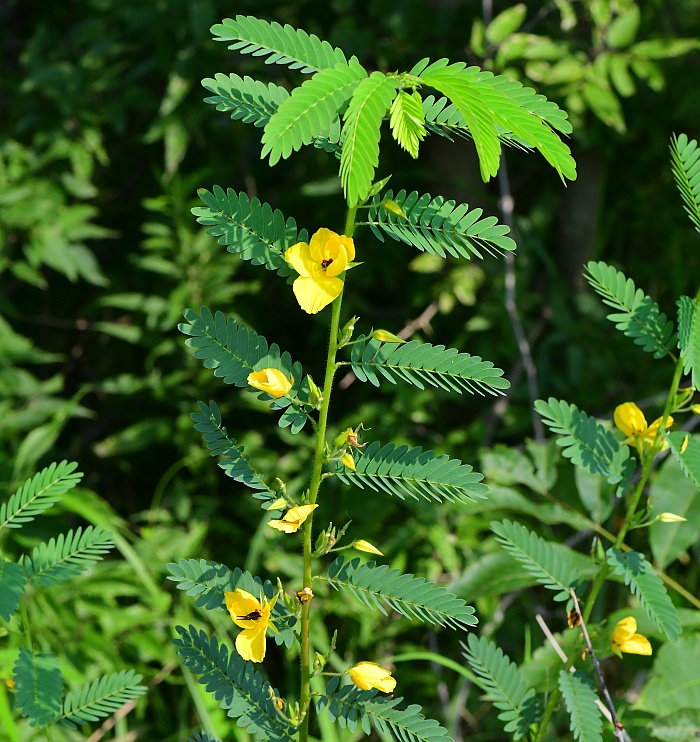Chamaecrista fasciculata (Michx.) Greene
Showy Partridge-Pea

Native
CC = 2
CW = 3
MOC = 94
© SRTurner
Chamaecrista fasciculata (Michx.) GreeneShowy Partridge-Pea | |
 |
Native CC = 2 CW = 3 MOC = 94 |
© SRTurner |
|
Family - Fabaceae/Caesalpinioideae Habit - Taprooted annual forb, with nodules present on roots. Stems - Ascending to erect, to 90 cm, with antrorse pubescence, branching, often purplish.
Leaves - Alternate, stipulate, petiolate, even-pinnate, with 10-15 pairs of leaflets. Stipules 7-16 mm long, 1-2 mm wide at base, narrowly and usually asymmetrically lanceolate-triangular, long-tapered at tip, with antrorse pubescence, erect, green, prominently veined. Petiole with a gland on the adaxial face, this sessile or occasionally short-stalked, 1.0-1.8 mm in diameter. Leaflets opposite, 10-20 mm long, 2-5 mm wide, oblong, sessile, entire, usually glabrous, glaucous below, green above, mucronate, oblique at the base, the margins short-hairy.
Inflorescence - Axillary clusters of 1-3 flowers, with usually only 1 flower open at a time, the stalks 10-15 mm long, the bracts 3-6 mm long, similar to stipules. Pedicels to 2 cm long, antrorse pubescent.
Flowers - Noticeably asymmetric, 25-30 mm in diameter. Sepals 10-12 mm long, 2-3 mm wide, lanceolate, sharply pointed, often hairy. Petals 15-20 mm long, 8-18 mm wide, broadly obovate, clawed, subequal, with one lateral petal curved around the stamens, the lower petal only slightly larger than the others, yellow, some reddish-tinged toward the base, glabrous. Stamens 10, unequal, to 1 cm long, with 9 smaller stamens grouped on one side of the pistil and 1 large stamen on the opposite side, the anthers 6-10 mm long, deep purple. Ovary 4-5 mm long, hairy with white matted hairs, the style 6-7 mm long, becoming glabrous towards apex, curved.
Fruits - Legumes 3-6 cm long, 5-6 mm wide, flattened, sparsely to moderately hairy, especially along the margins, black when fully mature, elastically dehiscent. Seeds 3.2-4.0 mm long, 2.0-2.4 mm wide, nearly square, the surfaces finely pitted, dark brown to black, not shiny.
Flowering - July - October. Habitat - Upland prairies, glades, forest openings, fields, pastures, roadsides, railroads. Origin - Native to the U.S. Lookalikes - Chamaecrista nictitans. Other info. - This pretty plant is found throughout most of Missouri, and across most of the eastern half of the U.S. When in flower it is easy to identify, and the large yellow flowers are easy to spot along roadways. Its close sibling, C. nictitans, looks very similar except which much smaller flowers. When not flowering, the two can be hard to tell apart. The presence or absence of a stalk on the petiolar gland is apparently not reliable, at least for Missouri plants. The fruits of this species are elastically dehiscent and can fling seeds quite a good distance. Hence, the plant spreads quickly and can take over a garden if not controlled carefully. Several infraspecific forms have been described by various authors, based on numerous morphological characters, but these are not formally recognized in Missouri. Photographs taken off 63rd St, Jackson County, MO., 7-22-00, and in Ellington, MO., 6-7-03 (DETenaglia); also at Weldon Spring Conservation Area, St. Charles County, MO, 7-27-2009, Little Lost Creek Conservation Area, Warren County, MO, 8-8-2012, B. K. Leach Memorial Conservation Area, Lincoln County, MO, 9-13-2021, and Marais Temps Clair Conservation Area, St. Charles County, MO, 7-25-2024 (SRTurner); also at B. K. Leach Memorial Conservation Area, Lincoln County, MO, 9-13-2021 (KBildner). |